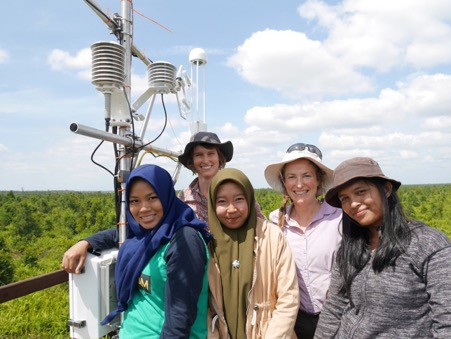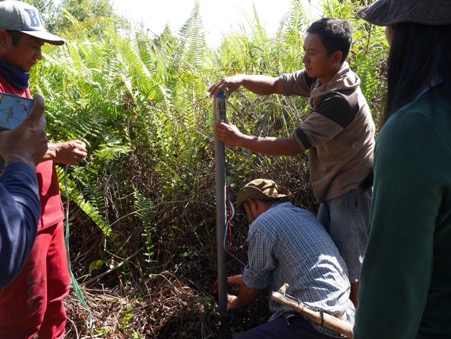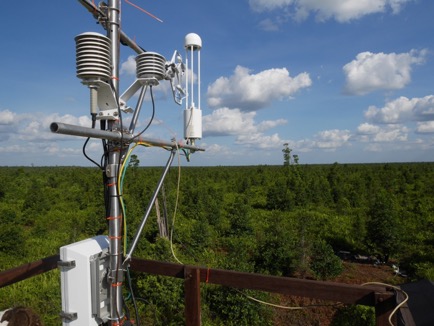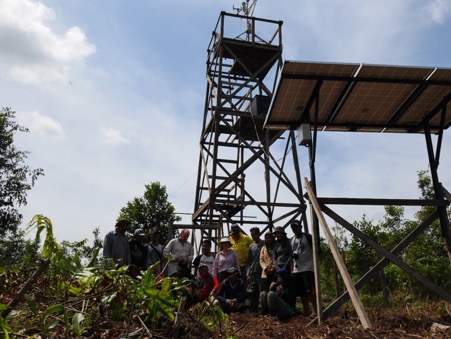Automated environmental monitoring data sensors have just been installed in a patch of Indonesian wetland, the size of Melbourne, to quantify the stocks and flows of greenhouse gases—and ensure the success of restoration efforts.
Battling extreme heat and the threat of impending fires, a team of 30 Indonesian and Australian researchers and technicians has successfully installed a suite of automated environmental monitoring infrastructure in a 10,000 km2 degraded peatland in Kalimantan, Indonesia.
A 10 m tall sensor-laden eddy-covariance flux tower now captures detailed data on the exchanges of energy, CO2, methane and water between the land and atmosphere, while on-ground sensors track soil moisture throughout seasonal changes. The tower sits in a 50,000 ha heavily drained and degraded section of a tropical peat swamp forest. The forest is managed by the Borneo Orangutan Survival Foundation, BOSF-Mawas Program, as part of their 309,000 ha landscape-scale environmental monitoring, forest restoration and conservation efforts.
A year in the planning, the five-day field campaign combined world-leading scientific expertise with in-depth local knowledge and logistical support. Dr Samantha Grover, a soil scientist and lecturer at Australia’ RMIT University says that Indonesian and Australian researchers and government land managers will use the data collected to assess the success of efforts to restore the peatland from degraded peatland to tropical peat swamp forest.
“Indonesia’s tropical peatlands are a globally significant store of carbon, a locally critical water reservoir and some of the last remaining habitat for orangutans on the planet. Drainage and fires that have devastated these landscapes and present a huge challenge to restoration efforts.
As Indonesian and international efforts to restore degraded peatlands pick up speed, we are working to develop tools to monitor and evaluate peatland recovery. The opportunity to work together with Universitas Palangka Raya and BOSF researchers to develop tools to support restoration efforts is a privilege and the project has been an amazing learning opportunity for everyone.”

Samantha says that students from the University of Palangka Raya and RMIT University were a key part of the installation campaign, learning and contributing to the instrument set up. Zafruallah Damanik, a researcher and project leader from the University of Palangka Raya says:
“All of the team members and students came to better understand the eddy covariance and soil-moisture sensor approaches over the course of the installation and there were many conversations about their possible use in tropical peatland restoration and fire prevention efforts across Indonesia.”

Professor Jason Beringer of the University of Western Australia was one of the Australian scientists called upon to help the team install the research data repository equipment.
“We had long days in the tropical heat installing scientific equipment, but we now have a full set of instruments measuring the greenhouse gases, including methane, being released from these areas, and investigating how regrowing the forest can take back some of the carbon dioxide.
TERN has, in part, been a catalyst that has enabled the envisaging of this project through networking and providing a scientific foundation. Extensive knowledge and skills have been acquired within TERN OzFlux that are now able to be transferred to our international neighbours in Indonesia.”
Planning for a second socialisation workshop with local government stakeholders, including a field visit component as well as sharing the initial data collected by the team, is underway. We look forward to updating you on the progress of these exciting events and plans via future editions of the TERN eNewsletter. Congratulations to the team and all involved in this wonderful bilateral project.
- This project is funded by the Australian Centre for International Agricultural Research: “Trial of techniques to empower community and government monitoring and evaluation of Indonesian peatland restoration SLaM 2018 122” led by Dr Samantha Grover from RMIT University. It is a collaboration with industry partner Campbell Scientific which has provided the CO2, H2O, wind speed and direction sensors and data logger. For more information, please contact Samantha via email.








